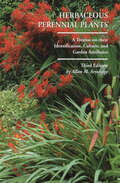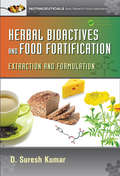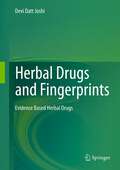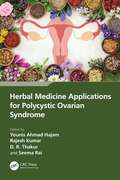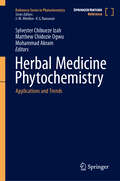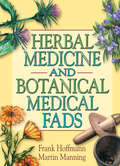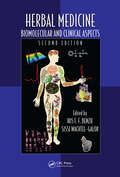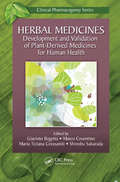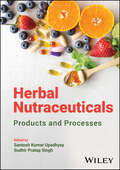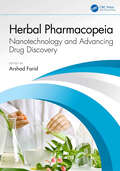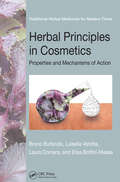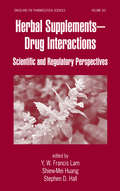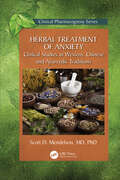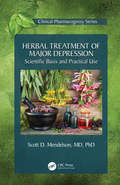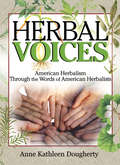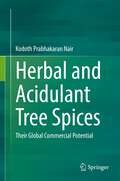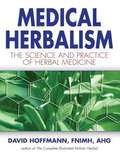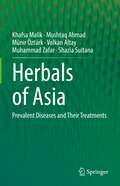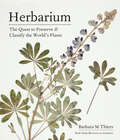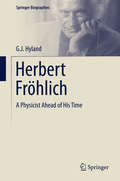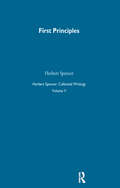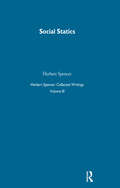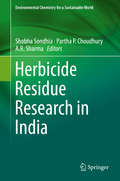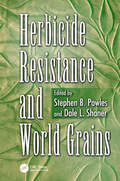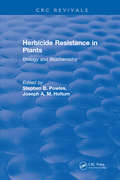- Table View
- List View
Herbaceous Perennial Plants: A Treatise on their Identification, Culture, and Garden Attributes
by Allan M. ArmitageThe third edition of the comprehensive—and entertaining—gardening reference by the master horticulturalist.This is the long-awaited third edition of Allan Armitage’s masterpiece on garden perennials. Armitage’s extensive traveling, teaching, and trialing experiences provide a depth of understanding of the best ornamental perennials for North American gardens unparalleled by any other garden writer. One of the most definitive and conclusive books written about perennials, the first edition was designated as one of the best seventy-five books written in the last seventy-five years by the American Horticulture Society. Now the third edition of “The Big Perennial Book” (as it is fondly referred to by many practitioners) describes 3,600 species in 1224 pages. More than three hundred color photos complement detailed text filled with the author’s pointed observations of plant performance, cultivar selection, and current taxonomy. In addition, his trademark wit and passion are both in abundance, making reading as pleasurable as it is informative.
Herbal Bioactives and Food Fortification: Extraction and Formulation (Nutraceuticals Ser. #4)
by D. Suresh KumarRecent major shifts in global health care management policy have been instrumental in renewing interest in herbal medicine. However, literature on the development of products from herbs is often scattered and narrow in scope. Herbal Bioactives and Food Fortification: Extraction and Formulation provides information on all aspects of the extraction o
Herbal Drugs and Fingerprints
by Devi Datt JoshiEvidence based herbal drugs are on hi-acceptance day by day due to health friendly nature compared to synthetic drugs. The active ingredients in herbal drugs are different chemical classes, e.g. alkaloids, coumarins, flavonoids, glycosides, phenols, steroids, terpenes etc., are identified at molecular level using current analytical practices, which are unique characteristic, as finger, so known as fingerprints. The fingerprints are used for assessment of quality consistency and stability by visible observation and comparison of the standardized fingerprint pattern, have scientific potential to decipher the claims made on these drugs for authenticity and reliability of chemical constituents, with total traceability, which starts from the proper identification, season and area of collection, storage, their processing, stability during processing, and rationalizing the combinational in case of polyherbal drugs. These quality oriented documents have ample scientific logics so well accepted globally by regulatory authorities and industries, to determine intentional/ unintentional contamination, adulteration, pollutants, stability, quality, etc. parameters. Based on geo-climatic factors, a same plant species has different pharmacological properties due to different ingredients; such regional and morphological variations are identified by fingerprints, at the time of collection of the medicinal herb. The chromatographic (TLC, HPTLC, HPLC, GC,) and spectral (UV-Vis., FTIR, MNR, MS, LC-MS, GC-MS etc.) techniques have world-wide strong scientific approval as validated methods to generate the fingerprints of different chemical classes of active ingredients of herbal drugs. Presently there is a need for a book having all the fingerprinting techniques for herbal drugs at a place with theory, case studies and art to discover patentable forms. The present book is a mile stone in the subject, to be utilized by Scientists, Medical Doctors, Technicians, Industrialists, Researchers, and Students both in PG and UG levels.
Herbal Medicine Applications for Polycystic Ovarian Syndrome
by Rajesh Kumar Younis Ahmad Hajam D. R. Thakur Seema RaiPolycystic ovarian syndrome (PCOS) is a multifaceted reproductive, metabolic syndrome, and its symptoms involve interactions between hormones, genes, and environmental stressors. The characteristic symptoms of PCOS include menstrual abnormalities such as oligomenorrhea or amenorrhea. The general symptoms of PCOS are anovulation or oligo-ovulation.Herbal Medicine Applications for Polycystic Ovarian Syndrome provides comprehensive information on different aspects of PCOS, including its pathogenesis, symptoms, therapies, and management, particularly through herbal remedies. With 13 chapters related to different aspects of PCOS, this book provides enormous knowledge about the pathogenesis and role of different therapeutic strategies globally. These chapters have been contributed by researchers from across the globe from Europe to Asia, who highlight the importance of herbal medicines in the treatment of a reproductive disorder such as PCOS.This book also serves as a simple compendium for undergraduate and postgraduate students, researchers, and pharmaceutical companies to understand the fundamental concepts of herbal treatment use with regard to basic mechanisms, sources, and positive impact. Readers will find an articulate package of knowledge compiled about pathogenesis and complications of PCOS and the role of herbs in the development of drugs for the treatment of reproductive disorders.
Herbal Medicine Phytochemistry: Applications and Trends (Reference Series in Phytochemistry)
by Muhammad Akram Sylvester Chibueze Izah Matthew Chidozie OgwuThis book offers a comprehensive perspective of herbal medicine phytochemistry and explores the application of plant extracts as bioactive compounds in disease prevention and treatment in modern or traditional medicine. The book starts with an introduction to the history and value of herbal medicine, followed by 3 parts covering the main phytochemical components and metabolites in herbal medicine, different uses and practices in herbal medicine, including a region-wise analysis of methods and practices and an overview of regulations and policies for herbal medicinal practitioners, and the advances and challenges in quality assessment of herbal medicine. Plants generally have the tendency to bioaccumulate trace metals from the environment and they are easily contaminated by microorganisms from water sources and poor hygiene practices of the herbalist. Quality assessment and assurance is, thus, a pertinent challenge in herbal medicine practice (i.e., in remedy formulation and application), and this book offers an authoritative perspective on this topic, covering aspects such as quality control strategies, preparation techniques, chemical quantification in phytomedicine, and the efficacy and safety of herbal remedies. Moreover, in this book, readers will find valuable insights into the latest trends and developments in the field, and a critical review of the application of medicinal plants to treat cardiovascular, digestive, respiratory neurological and reproductive diseases. Particular attention is given to the advances and trends in the field, and readers will learn about the latest biotechnological approaches, the use of nanotechnology in herbal medicine, metabolomic analysis of medicinal plants, big data application in herbal medicine, and the value of herbal medicine towards sustainability. Given its breadth, this book is aimed at researchers, academics, practitioners and professionals working in the fields of natural, life, health, clinical, and biomedical sciences, and interested in herbal remedies, pharmacology, pharmacognosy, human nutrition and dietetics, plant biology, and biotechnology/microbiology.
Herbal Medicine and Botanical Medical Fads
by Frank Hoffmann Martin J ManningFind all the information you need on herbs and spices in one place!Herbal Medicine and Botanical Medical Fads is an A-to-Z reference book written in a straightforward style that’s informative enough for library use but informal enough for general reading. This essential guide takes a practical look at the popular uses of herbs and spices, presented in an easy-to-use format. The book is a refreshing alternative to the how-to guides, cookbooks, and picture books usually found on the subject.From alfalfa to ginseng to yellow dock, more than 100 entries are included, featuring historical backgrounds, popular and practical uses, folklore, and bibliographies. Herbal Medicine and Botanical Medical Fads also contains related listings and essays that range from alternative medicine to food preparation and nutrition to herbs in wedding celebrations. Detailed enough for reference use by academics, the book has a natural tone that appeals to garden club members, herb and spice experts, hobbyists, and others. Herbal Medicine and Botanical Medical Fads also includes information on: herb growing and marketing herbs and spices in literature medicinal herbs and spices federal regulations on herbs and spices horticulture therapyAn everyday guide for enthusiasts and a perfect place to start for newcomers, Herbal Medicine and Botanical Medical Fads is an easy-to-use handbook with wide-ranging appeal. It combines the comprehensive information you&’d expect from a reference book with a casual and colorful look at the histories and backgrounds of herbs and spices, both commonplace and exotic. As a vital resource or an occasional reference, this book is unique in its scope and invaluable in its usefulness.
Herbal Medicine: Biomolecular and Clinical Aspects, Second Edition (Oxidative Stress and Disease)
by Iris F. F. Benzie Sissi Wachtel-GalorThe global popularity of herbal supplements and the promise they hold in treating various disease states has caused an unprecedented interest in understanding the molecular basis of the biological activity of traditional remedies. Herbal Medicine: Biomolecular and Clinical Aspects focuses on presenting current scientific evidence of biomolecular ef
Herbal Medicines: Development and Validation of Plant-derived Medicines for Human Health (Clinical Pharmacognosy Series)
by Giacinto Bagetta Marco Cosentino Maria Tiziana Corasaniti Shinobu SakuradaThe deregulation of dietary supplements and natural products marketing by the FDA has widened the natural products market in Europe and worldwide. While the discussion about the validity of the plant approach to nutrition and diseases treatment continues, the explosion of the use of whatever is considered "natural" has generated concern about effec
Herbal Nutraceuticals: Products and Processes
by Santosh Kumar Upadhyay Sudhir Pratap SinghHolistic approach to the herbal aspects of nutraceuticals and their implementation in the health and agriculture sectors Herbal Nutraceuticals: Products and Processes delivers comprehensive coverage of the herbal aspects of nutraceuticals along with their many applications in the health and agriculture sectors. The book begins with an overview of plant-based nutraceuticals and the role of plant biotechnology in nutraceutical production. Each chapter covers a unique topic related to nutraceuticals and the positive and negative implications associated with each substance discussed. The text concludes by addressing safety concerns associated with microalgal nutraceuticals and discussing toxicity evaluation of nutraceuticals overall. Written by two academics with significant experience in the field, Herbal Nutraceuticals: Products and Processes includes information on: Significance of nutraceuticals in modern health maintenance and disease prevention, and applications of spices in nutraceuticals Antioxidant properties and anti-ageing potential of food plants, beverages such as herbal wine, and nutraceuticals Nutraceuticals with anti-diabetic, anti-inflammatory, and anti-carcinogenic potentials, and sources, medicinal properties, and applications of carotenoids in food and the nutraceutical industry Nutraceuticals in legumes, herbal beverages, edible oils, conventional and nonconventional fruits, staple food crops, and pseudocereals Herbal Nutraceuticals: Products and Processes is an essential up-to-date reference on the subject for academics and researchers, as well as professionals and research institutions involved in agri-biotech product development.
Herbal Pharmacopeia: Nanotechnology and Advancing Drug Discovery
by Arshad FaridThis book comprehensively explores the intersection between traditional herbal medicine and cutting-edge nanotechnology. The chapters introduce modern techniques used in herbal extraction and analysis. The principles of drug discovery from plants are discussed, with a focus on the identification and development of bioactive compounds that have therapeutic potential. It discusses the pharmacological properties, biotechnological approaches in drug development, and challenges in the formulation and standardization of herbal medicines. Emerging trends and applications of nanotechnology in herbal pharmacotherapy, such as nanoparticle synthesis, enhanced bioavailability using nanocarriers, safety assessments, novel and targeted delivery systems, and regulatory considerations, are thoroughly discussed. Additionally, it includes a comparative analysis of traditional and nano-formulated approaches and their implementation in clinical settings. Towards the end, the book reviews the regulatory considerations for herbal products and future perspectives in herbal pharmacopeia. This book is intended for researchers, clinicians, and professionals in herbal medicine, pharmacology, and nanotechnology.
Herbal Principles in Cosmetics: Properties and Mechanisms of Action (Traditional Herbal Medicines for Modern Times)
by Luisella Verotta Bruno Burlando Laura Cornara Elisa Bottini-MassaInterest in the molecular and mechanistic aspects of cosmetic research has grown exponentially during the past decade. Herbal Principles in Cosmetics: Properties and Mechanisms of Action critically examines the botanical, ethnopharmacological, phytochemical, and molecular aspects of botanical active ingredients used in cosmetics. Along with dermato
Herbal Supplements-Drug Interactions: Scientific and Regulatory Perspectives (Drugs and the Pharmaceutical Sciences)
by Shiew-Mei Huang Stephen D. Hall Y W. Francis LamThe international popularity of herbal remedies has recently outpaced quality information on the utilization and dosing of these compounds. This book fills a void in the literature by offering an authoritative overview of the mechanisms of herbal remedies and their impact on standard medications. It offers a practical approach that focuses not only
Herbal Treatment of Anxiety: Clinical Studies in Western, Chinese and Ayurvedic Traditions (Clinical Pharmacognosy Series)
by Scott D. MendelsonHerbal Treatment of Anxiety: Clinical Studies in Western, Chinese and Ayurvedic Traditions explains the nature and types of anxiety, its neurobiology, the pathophysiology that exacerbates and perpetuates it, and the psychopharmacology of the chemical agents that relieve its manifestations. Throughout the text are discussions of Western, Chinese and Ayurvedic herbal treatments that have been clinically shown to be effective in relieving anxiety. The book also features a scientific discussion of the use of herbs and essential oils in aromatherapy and the mechanisms by which they may work. The book concludes by providing bases upon which herbs can be chosen to treat the anxiety of patients according to their individual needs. Additional features include: Examines the increasingly popular subject of the use of herbs as a natural alternative treatment and provides a much-needed scientific basis for treatments often considered as merely "folk medicine." Discusses the psychoactive phytochemicals contained in herbs. Includes a chapter discussing the nature and mechanisms of action of adaptogens. Adds to the armamentarium of anxiolytics for providers who have become reluctant to prescribe benzodiazepines as treatment of anxiety, particularly in the context of the opiate crisis. Gives an introduction to herbal treatments of traditional Chinese and Ayurvedic medicine. Offers practical advice on initiating and managing herbal treatments. Herbal Treatment of Anxiety is a valuable reference for psychiatrists, psychiatric nurse practitioners, primary care providers, naturopathic doctors and therapists interested in the most current scientific information on the effects of herbal treatments of anxiety disorders.
Herbal Treatment of Major Depression: Scientific Basis and Practical Use (Clinical Pharmacognosy Series)
by Scott D MendelsonThis unique volume presents new understandings of the neurochemical nature of major depression, and how herbs and their constituent flavonoids and terpenes appear to address some of the mechanisms now thought to be involved. It explores how recent studies of the rapid antidepressant effects of ketamine inform neuroscientists about deep intracellular mechanisms of antidepressant action that have little to do with simple enhancement of monoaminergic activity. These mechanisms include actions on PI3K, Akt, mTOR, GSK3, BDNF, and other intracellular pathways. New theories of the pathophysiology underlying major depression, such as oxidative damage, inflammation, stress and insulin resistance are then explored.Key Features: Focuses on oxidative damage, inflammation, and metabolic syndrome. Explains that a significant percentage of people treated for major depression obtain little if any relief from standard antidepressant medications. These facts lead to discussion of herbs that can be used to treat major depression, as well as consideration of the scientific basis for how these herbs act. The antidepressant properties of 66 herbs are discussed, along with dosing and safety information.
Herbal Voices: American Herbalism Through the Words of American Herbalists
by Ethan B Russo Anne DoughertyLearn how traditional herbal practitioners are responding to the sudden, massive popularity of herbal medicine! Herbal Voices: American Herbalism Through the Words of American Herbalists examines how herbal practitioners who started in the 1960s and 1970s are reacting to the mainstream popularity of herbal medicine today. This unique book features interviews with 20 of America&’s most prominent herbalists-focusing on their careers, their beliefs, and their perspectives on the contemporary herbal product boom in recent years. Also included is important information on herbal organizations, publications, schools, and companies where seeds and rootstock of endangered medicinal plants can be obtained, as well as a list of the United Plant Savers&’ "At Risk" and "To Watch" medicinal plants. Herbal Voices synthesizes the words of a representative group of herbalists into a compelling picture of modern American herbalism as they offer their opinions on the roles of science, folklore, and spirituality in herbal medicine. This timely resource addresses controversial issues that arise within the herbal community, such as the endangered plant crisis, professionalism and licensure, and shifting the American consciousness toward a more Earth-centered way of life and health. In Herbal Voices, you&’ll hear from many well-known herbal practitioners, including: Rosemary Gladstar-founder of The California School of Herbal Studies and United Plant Savers, co-founder of Sage Mountain Herbs, and author of Herbal Healing for Women and of the Sage Healing Way series James Green-former Director of The California School of Herbal Studies, a member of the advisory committee for United Plant Savers, and author of both The Herbal Medicine-Makers Handbook and The Male Herbal David Hoffmann-Fellow of Britain&’s National Institute of Medical Herbalists, former President of the American Herbalists Guild, and author of The New Holistic Herbal, An Elder&’s Herbal, and Therapeutic Herbalism Richo Cech-herbalist, owner of Horizon Herbs, executive board member of United Plant Savers, and author of Growing Your Garden Pharmacy Sharol Tilgner-licensed naturopathic physician, founder and current President of Wise Woman Herbals, Inc., editor of Herbal Transitions, associate editor of Medical Herbalism, and author of Herbal Medicines From the Heart of the Earth For the first time, these leading educators, clinicians, and business owners share the joys and pitfalls of practicing an age-old healing tradition in modern America. This rich resource of reflections fills a gap in the existing literature that will be useful for herbalists, herbal enthusiasts, historians, anthropologists, popular culturists, and holistic/alternative medical practitioners.
Herbal and Acidulant Tree Spices: Their Global Commercial Potential
by Kodoth Prabhakaran NairThis book discusses leafy spices or herbs known as “aromatic herbs”, which, apart from being used in culinary art for flavoring of foods and beverages, are also known to possess antiseptic, anti-oxidant and other medicinal properties, in addition to many nutraceutical and cosmetic properties. Of the numerous herbs twelve of the commercially important herbs are imported into 4 major European markets, namely, France, Germany, United Kingdom and The Netherlands to the tune of 12000 to 13000 tonnes per annum. This book discusses these leafy herbs and their tremendous commercial potential in international trade. The book offers a comprehensive insight into commercial herbs, with an objective of enhancing their yield, and provides a platform for further research into the global trade potential.
Herbalism: The Science and Practice of Herbal Medicine
by David HoffmannA foundational textbook on the scientific principles of therapeutic herbalism and their application in medicine. A complete handbook for the medical practitioner - Includes the most up-to-date information on preparations, dosage, and contraindications - By the author of The Complete Illustrated Holistic Herbal Medical Herbalism contains comprehensive information concerning the identification and use of medicinal plants by chemical structure and physiological effect, the art and science of making herbal medicine, the limitations and potential of viewing herbs chemically, and the challenge to current research paradigms posed by complex plant medicines. It also includes information on toxicology and contraindications, the issues involved in determining dosage and formulation types for an individual, guides to the different measurement systems and conversion tables, and the pros and cons of both industrial and traditional techniques. With additional sections devoted to the principles of green medicine, the history of Western Herbalism, the variety of other medical modalities using medicinal plants, an extensive resource directory, and a discussion of treatments organized by body system, Medical Herbalism is the comprehensive textbook all students and practitioners of clinical herbalism need to develop their healing practices.
Herbals of Asia: Prevalent Diseases and Their Treatments
by Mushtaq Ahmad Muhammad Zafar Münir Öztürk Volkan Altay Shazia Sultana Khafsa MalikMedicinal flora plays an important role in health care systems across the world. Out of the half million flowering plants, around 50.000 species are valued for their therapeutic properties. During the last few decades, 20% of the world’s population used plants and/or their derived products as a source of medicine. WHO stated that 80% population around the globe, specifically the rural communities, depend on medicinal plants for their basic healthcare needs. To this end, plant-based phytochemicals are known to have hepato-protective, anti-carcinogenic, anti-allergic, anti-inflammatory, antimicrobial, antioxidant actions. This book is a guide to ~280 plant species of medicinal flora that demonstrates global relevance. Our goal is to share local knowledge about phytomedicines to a worldwide audience. It is an illustrated reference that documents and preserves the existing knowledge on these plant taxa, with a social and cultural (ethnobotanical) emphasis. This book also provides comprehensive and useful information about traditional uses of medicinal plants by the local communities for the treatment of various prevalent diseases. It contains comprehensive descriptions of each species including family, synonyms, English name, distribution, altitude, habitat, morphological description, life form, part used, mode of utilization, diseases category, recipes, other medicinal uses, phytochemical activity and toxicity.
Herbarium: The Quest to Preserve and Classify the World's Plants
by Barbara M. ThiersA treasury like no other Since the 1500s, scientists have documented the plants and fungi that grew around them, organizing the specimens into collections. Known as herbaria, these archives helped give rise to botany as its own scientific endeavor.Herbarium is a fascinating enquiry into this unique field of plant biology, exploring how herbaria emerged and have changed over time, who promoted and contributed to them, and why they remain such an important source of data for their new role: understanding how the world&’s flora is changing. Barbara Thiers, director of the William and Lynda Steere Herbarium at the New York Botanical Garden, also explains how recent innovations that allow us to see things at both the molecular level and on a global scale can be applied to herbaria specimens, helping us address some of the most critical problems facing the world today. At its heart, Herbarium is a compelling reminder of one of humanity&’s better impulses: to save things—not just for ourselves, but for generations to come.
Herbert Fröhlich
by G. J. HylandThis biography provides a stimulating and coherent blend of scientific and personal narratives describing the many achievements of the theoretical physicist Herbert Fr#65533;hlich. For more than half a century, Fr#65533;hlich was an internationally renowned and much respected figure who exerted a decisive influence, often as a 'man ahead of his time', in fields as diverse as meson theory and biology. Although best known for his contributions to the theory of dielectrics and superconductivity, he worked in many other fields, his most important legacy being the pioneering introduction quantum field-theoretical methods into condensed matter physics in 1952, which revolutionised the subsequent development of the subject. Gerard Hyland has written an absorbing and informative account, in which Herbert Fr#65533;hlich's magnetic personality shines through.
Herbert Spencer: Collected Writings
by Herbert SpencerHerbert Spencer (1820-1903) was regarded by the Victorians as the foremost philosopher of the age, the prophet of evolution at a time when the idea had gripped the popular imagination. Until recently Spencer's posthumous reputation rested almost excusively on his social and political thought, which has itself frequently been subject to serious misrepresentation. But historians of ideas now recognise that an acquaintance with Spencer's thought is essential for the proper understanding of many aspects of Victorian intellectual life, and the present selection is designed to answer this need. It provides a cross-section of Spencer's works from his more popular and approachable essays to a number of the volumes of the Synthetic Philosophy itself. Volume V: First Principles.
Herbert Spencer: Or, The Conditions Essential To Human Happiness Specified, And The First Of Them Developed
by Herbert SpencerHerbert Spencer (1820-1903) was regarded by the Victorians as the foremost philosopher of the age, the prophet of evolution at a time when the idea had gripped the popular imagination. Until recently Spencer's posthumous reputation rested almost excusively on his social and political thought, which has itself frequently been subject to serious misrepresentation. But historians of ideas now recognise that an acquaintance with Spencer's thought is essential for the proper understanding of many aspects of Victorian intellectual life, and the present selection is designed to answer this need. It provides a cross-section of Spencer's works from his more popular and approachable essays to a number of the volumes of the Synthetic Philosophy itself. Volume III: Social Statics, Or the Conditions Essential to Human Happiness specified and then the fifst of them Developed.
Herbicide Residue Research in India (Environmental Chemistry for a Sustainable World #12)
by Shobha Sondhia Partha P. Choudhury A. R. SharmaHerbicides constitute about 60% of the total pesticides consumed globally. In India, the use of herbicides started initially in tea gardens and picked up in the 1970s, when the high-yielding varieties of rice and wheat were introduced. Presently, 67 herbicides are registered in the country for controlling weeds in crops including cereals, pulses, oilseeds, fibre and tuber crops, and also in the non-crop situations. These chemicals are becoming increasingly popular because of their efficiency and relatively low cost compared with manual or mechanical weeding operations. The contribution of herbicide to total pesticide use, which was only 10-15% during the first decade of the 21st century, has now increased to about 25% with an annual growth rate of 15-20%, which is much higher than insecticides and fungicides. Though the application of herbicides is minimizing yield loss to a great extent, their residues in the food chain and surface and groundwater create some environmental nuisance particularly to non-target organisms. Research on pesticide residues in India was started during 1970s, when such chemicals were introduced on a greater scale along with high-yielding variety seeds, irrigation and chemical fertilizers for increasing food production. However, the herbicide residue research was not given much emphasis until 1990s. The Indian Council of Agricultural Research initiated a national level programme known as All India Coordinated Research Project on Weed Management through the NRC-Weed Science as the main centre along with some centers of ICAR Institutes and state agricultural universities. Over the last two decades, adequate information was generated on estimation, degradation and mitigation of herbicide residues, which were documented in annual reports, bulletins, monographs and scientific articles. However, there was no consolidated compilation of all the available information providing a critical analysis of herbicide residues. Accordingly, an effort has been made in the publication to compile the available information on herbicide residues in India. This is the first report of its kind which presents the findings of herbicide residues and their interactions in the biotic and abiotic environment. There are 16 chapters contributed by the leading herbicide residue scientists, each describing the present status of herbicide use, crops and cropping systems, monitoring, degradation and mitigation, followed by conclusions and future lines of work.This book will be useful to the weed scientists in general and herbicide residue chemists in particular, besides the policy makers, students and all those concerned with the agricultural production in the country.
Herbicide Resistance and World Grains
by Stephen B. Powles Dale L. ShanerWritten by experts from across the globe, Herbicide Resistance and World Grains evaluates the weed and herbicide management systems in major world grain crops such as soybean, maize, rice, and canola. The book examines the impact of transgenic crops and new technology on resistance management. It provides background information and offers practical
Herbicide Resistance in Plants: Biology and Biochemistry
by Stephen B. PowlesThe late 1980s saw an explosion in the amount and diversity of herbicide resistance, posing a threat to crop production in many countries. The rapid escalation in herbicide resistance worldwide and in the understanding of resistance at the population, biochemical, and molecular level is the focus of this timely book. Leading researchers from North America, Australia, and Western Europe present lucid reviews that consider the population dynamics and genetics, biochemistry, and agro-ecology of resistance. Resistance to various herbicides is discussed in detail, as well as the mechanisms responsible for cross resistance and multiple resistance. This reference is invaluable to those interested in evolution and the ability of species to overcome severe environmental stress.
